An Integrated Multi-Objective Optimization for Dynamic Airport Shuttle Bus Location, Route Design and Departure Frequency Setting Problem
Abstract
1. Introduction
2. Related Work
3. Research Gaps and Contributions
- Although some studies have performed a synergistic optimization of route design and frequency determination in CBNs, these factors have rarely been considered in ASBNs. Due to the disparity between demand patterns and route architectures when people at demand points can walk or transfer to one of the nearest stations to get on and off the ASB, in comparison to the conventional integration model, the comprehensive operation of route design and frequency determination with the allocation of each demand point to the selected station was more effective [24].
- Such an integrated ASBN is a multi-objective NP-hard problem, and an effective heuristic method must be utilized to create a group of Pareto solutions to determine the ideal operational cost-to-convenience ratio for bus companies.
- Coordination of ASBN transit location, routing, and scheduling process in a dynamic environment to balance passenger and company benefits;
- Development of a two-phase multi-objective heuristic approach based on the non-dominated sorting genetic algorithm (NSGA-II) to acquire a group of Pareto-optimal solutions efficiently;
- Finally, an exact instance is used to demonstrate the effectiveness and practicality of this study.
4. Methodology
4.1. Research Framework
- Similarity according to the change characteristics of passenger flow per hour, a day can be divided into several periods, and the characteristics of each period can reflect the overall travel situation;
- An open GIS tool is used to acquire the changes in actual traffic distances and times between such nodes during different periods;
- Big data from mobile signals can be used to obtain the number of passengers at demand points during different periods.
4.2. Mathematic Formulation
4.2.1. Notation
4.2.2. Formulation
5. Solution Method
5.1. Phase I: Allocate Demand Points to Shuttle Bus Routes Using the NSGA-II Algorithm
5.2. Phase II: Search the Shortest Shuttle Bus Routes Using Greedy and Dynamic Programming Algorithms
| Algorithms 1. Airport shuttle bus route based on dynamic programming. | |
| Input | N: Number of selected stations, C: Coordinates of selected stations, dispatch center and airport. |
| Output | Shortest airport shuttle bus route. |
| Algorithm flowchart | yield selected station collection T and visited station collection V |
| //calculate the distance between the dispatch center and each selected station and store the | |
| results in array D | |
| for t ∈ T do | |
| D [1<<(t−1)][t] ← Distance(dispatch center to t) | |
| end for | |
| //calculate the distance when all remaining selected stations are visited. | |
| For V ∈ [0, 1, 2,…, (2N − 1)] do | |
| for t ∈ T do | |
| if t has not already visited then | |
| for previous ∈T do | |
| if previous has been already visited then | |
| D[V|(1<<(t − 1))][t] ← min(D[V][previous]+Distance(previous to t), | |
| D[V|(1<<(t − 1))][t] | |
| end if | |
| end for | |
| end if | |
| end for | |
| end for | |
| //calculate the distance between the last selected station and airport | |
| min_D ← Infinite | |
| for previous ∈T do | |
| min_D ← min(D[2N − 1][previous]+Distance(previous to airport),min_D) | |
| end for | |
6. Case Study
6.1. Case Description and Data Preparation
- Number of shuttle bus routes (B): 5;
- Maximum capacity of the shuttle bus (Q): 35 per bus;
- Minimum and maximum load factor ( and ): 0.4 and 2;
- Maximum transfer distance (): 5 km;
- Minimum and maximum departure frequencies for five periods ( and ): [2, 3, 2, 4, 2] and [5, 9, 6, 9, 5];
- Parameters of the hybrid algorithm: number of iterations is 500; number of chromosomes is 50; crossover rate is 0.9; mutation rate is 0.1.
6.2. Results
6.3. Comparative and Sensitivity Analyses
- (1)
- The growth in the number of routes resulted in some erroneous mileage and time, which increased the total route mileage because routes start at the dispatch center and end at the airport. Nevertheless, as the number of routes expanded, fewer stations were visited by each route, which decreased the passengers’ total ride time.
- (2)
- The ridership at demand points visited by each route declined as the number of routes increased, resulting in a decreased departure frequency. In this scenario, all passengers’ waiting times steadily increased. However, the total frequency increased, which led to a decrease in the mean load factor.
- (3)
- The total transfer distance fluctuated erratically with the number of routes raised.
- (1)
- Due to the increased station capacity, there was a reduction in the number of selected stations of each route, which resulted in a reduction in the total route mileage and the total ride time of passengers. However, as the number of selected stations decreased, the total transfer distance increased because the station nearest to the demand point may not have been selected.
- (2)
- As the station capacity increases, some stations may be assigned to different routes, which leads to changes in the total frequency and mean load factor. The total frequency changed irregularly, as did the total waiting time. Although, as station capacity increased, the total waiting time varied irregularly, the sum of the total ride time and the total waiting time gradually decreased, so the total travel time decreased.
- (1)
- As the load factor increased, the total frequency decreased, which increased the total waiting time. At the same time, the reduction in total frequency led to a decrease in the total route mileage and total trip time.
- (2)
- As the number of selected stations was not affected by the load rate, the total ride time remained essentially the same. The change in the total waiting time was more significant than the change in the total ride time; therefore, the trend in total travel time was associated with an increase in total passengers’ waiting time.
- (3)
- The total transfer distance changed irregularly with the increased load factor.
7. Conclusions
Author Contributions
Funding
Institutional Review Board Statement
Informed Consent Statement
Data Availability Statement
Acknowledgments
Conflicts of Interest
References
- Akbari-Kasgari, M.; Khademi-Zare, H.; Fakhrzad, M.B.; Hajiaghaei-Keshteli, M.; Honarvar, M. Designing a resilient and sustainable closed-loop supply chain network in copper industry. Clean Technol. Environ. Policy 2022, 24, 1553–1580. [Google Scholar] [CrossRef]
- Zhao, R.Q.; Liu, W.; Zhang, F.; Lodewijks, G. Passenger shuttle service network design in an airport. Transp. B Transp. Dyn. 2022, 10, 1099–1125. [Google Scholar] [CrossRef]
- Wei, M.; Sun, B.; Jing, B.; Wu, W. Fuzzy chance constrained programming model for demand-responsive airport shuttle bus scheduling problem. J. Nonlinear Convex Anal. 2020, 21, 1605–1620. [Google Scholar]
- Kaviyani-Charati, M.; Ghodsypour, S.H.; Hajiaghaei-Keshteli, M. Impact of adopting quick response and agility on supply chain competition with strategic customer behavior. Sci. Iran. 2022, 29, 387–411. [Google Scholar] [CrossRef]
- Hu, Q.; Xu, Q.; Xu, B. Introducing of online channel and management strategy for green agri-food supply chain based on pick-your-own operations. Int. J. Environ. Res. Public Health 2019, 16, 1990. [Google Scholar] [CrossRef]
- Fathollahi-Fard, A.M.; Dulebenets, M.A.; Tian, G.D.; Hajiaghaei-Keshteli, M. Sustainable supply chain network design. Environ. Sci. Pollut. Res. 2022. [CrossRef]
- Ibarra-Rojas, O.J.; Delgado, F.; Giesen, R.; Muñoz, J.C. Planning, operation, and control of bus transport systems: A literature review. Transp. Res. Pt. B Methodol. 2015, 77, 38–75. [Google Scholar] [CrossRef]
- Szeto, W.Y.; Jiang, Y. Transit route and frequency design: Bi-level modeling and hybrid artificial bee colony algorithm approach. Transp. Res. Pt. B Methodol. 2014, 67, 235–263. [Google Scholar] [CrossRef]
- Szeto, W.Y.; Wu, Y. A simultaneous bus route design and frequency setting problem for Tin Shui Wai, Hong Kong. Eur. J. Oper. Res. 2011, 209, 141–155. [Google Scholar] [CrossRef]
- Sun, B.; Wei, M.; Wu, W. An optimization model for demand-responsive shuttle transit services based on ride-sharing car. Information 2019, 10, 370. [Google Scholar] [CrossRef]
- Li, X.; Wei, M.; Hu, J.; Yuan, Y.; Jiang, H. An agent-based model for dispatching real-time demand-responsive shuttle bus. Math. Probl. Eng. 2018, 2018, 6925764. [Google Scholar]
- Wei, M.; Liu, T.; Sun, B.; Jing, B. Optimal integrated model for shuttle transit route design and frequency-setting problem with stop selection. J. Adv. Transp. 2020, 2020, 6517248. [Google Scholar] [CrossRef]
- Ruano-Daza, E.; Cobos, C.; Torres-Jimenez, J.; Mendoza, M.; Paz, A. A multi-objective bi-level approach based on global-best harmony search for defining optimal routes and frequencies for bus rapid transit systems. Appl. Soft Comput. 2018, 67, 567–583. [Google Scholar] [CrossRef]
- Brugal, M.T.; Barrio, G.; Fuente, L.D.L.; Regidor, E.; Royuela, L.; Suelves, J.M. Factors associated with nonfatal heroin overdose: Assessing the effect of frequency and route of heroin administration. Addiction 2002, 97, 319–327. [Google Scholar] [CrossRef] [PubMed]
- Buba, A.T.; Lee, L.S. A differential evolution for simultaneous transit network design and frequency setting problem. Expert Syst. Appl. 2018, 106, 277–289. [Google Scholar] [CrossRef]
- Nikoli, M.; Teodorovi, D. A simultaneous transit network design and frequency setting: Computing with bees. Expert Syst. Appl. 2014, 41, 7200–7209. [Google Scholar] [CrossRef]
- Ahern, Z.; Paz, A.; Corry, P. Approximate multi-objective optimization for integrated bus route design and service frequency setting. Transp. Res. Pt. B-Methodol. 2022, 155, 1–25. [Google Scholar] [CrossRef]
- López-Ramos, F.; Codina, E.; Marin, A.; Guarnaschelli, A. Integrated approach to network design and frequency setting problem in railway rapid transit systems. Comput. Oper. Res. 2017, 80, 128–146. [Google Scholar] [CrossRef]
- Sun, X.; Lin, K.; Jiao, P.P.; Deng, Z.L.; He, W. Research on transfer optimization model of county transit network. Int. J. Environ. Res. Public Health 2021, 18, 4962. [Google Scholar] [CrossRef]
- Shang, P.; Yang, L.Y.; Yao, Y.; Tong, L.; Yang, S.Y.; Mi, X.W. Integrated optimization model for hierarchical service network design and passenger assignment in an urban rail transit network: A Lagrangian duality reformulation and an iterative layered optimization framework based on forward-passing and backpropagation. Transp. Res. Pt. C Emerg. Technol. 2022, 144, 103877. [Google Scholar] [CrossRef]
- Zhou, Y.; Yang, H.; Wang, Y.; Yan, X.D. Integrated line configuration and frequency determination with passenger path assignment in urban rail transit networks. Transp. Res. Pt. B Methodol. 2021, 145, 134–151. [Google Scholar] [CrossRef]
- Wu, M.; Yu, C.; Ma, W.J.; An, K.; Zhong, Z.H. Joint optimization of timetabling, vehicle scheduling, and ride-matching in a flexible multi-type shuttle bus system. Transp. Res. Pt. C Emerg. Technol. 2022, 139, 103657. [Google Scholar] [CrossRef]
- Sigler, D.; Wang, Q.; Liu, Z.; Garikapati, V.; Kotz, A.; Kelly, K.J.; Lunacek, M.; Phillips, C. Route optimization for energy efficient airport shuttle operations-A case study from Dallas Fort worth International Airport. J. Air Transp. Manag. 2021, 94, 102077. [Google Scholar] [CrossRef]
- Li, X.; Wang, T.; Xu, W.; Li, H.; Yuan, Y. A novel model and algorithm for designing an eco-oriented demand responsive transit (DRT) system. Transp. Res. Pt. E Logist. Transp. Rev. 2022, 157, 102556. [Google Scholar] [CrossRef]
- Li, X.; Huang, J.; Guan, Y.; Li, Y.; Yuan, Y. Electric demand-responsive transit routing with opportunity charging strategy. Transp. Res. Part D Transp. Environ. 2022, 110, 103427. [Google Scholar] [CrossRef]
- Ma, C.X.; Wang, C.; Xu, X.C. A multi-objective robust optimization model for customized bus routes. IEEE Trans. Intell. Transp. Syst. 2021, 22, 2359–2370. [Google Scholar] [CrossRef]
- Wei, M.; Jing, B.; Yin, J.; Zang, Y. A green demand-responsive airport shuttle service problem with time-varying speeds. J. Adv. Transp. 2020, 2020, 9853164. [Google Scholar] [CrossRef]
- Ito, S.; Akaiwa, K.; Funabashi, Y.; Nishikawa, H.; Kong, X.; Taniguchi, I.; Tomiyama, H. Load and wind aware routing of delivery drones. Drones 2022, 6, 50. [Google Scholar] [CrossRef]
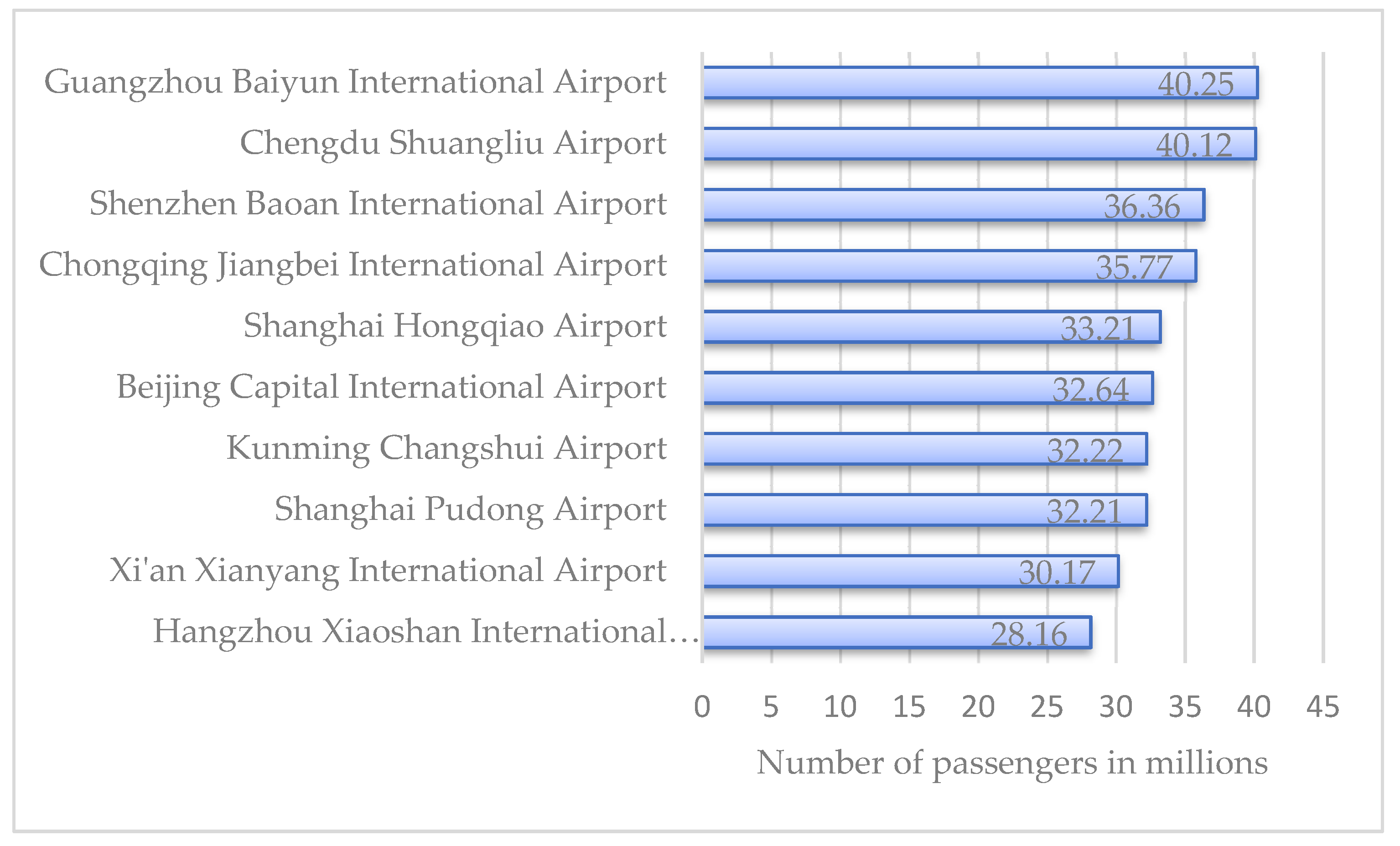
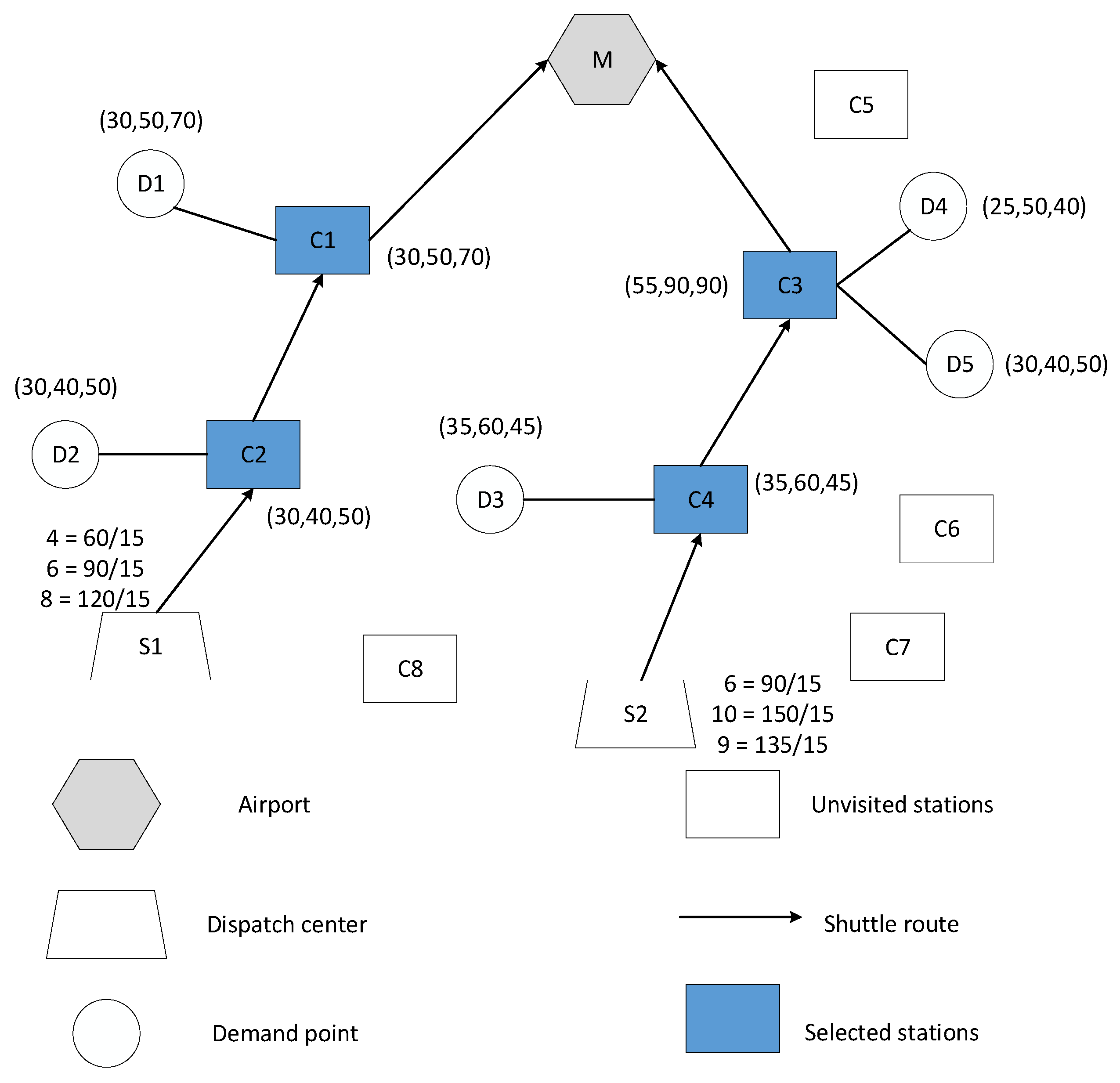
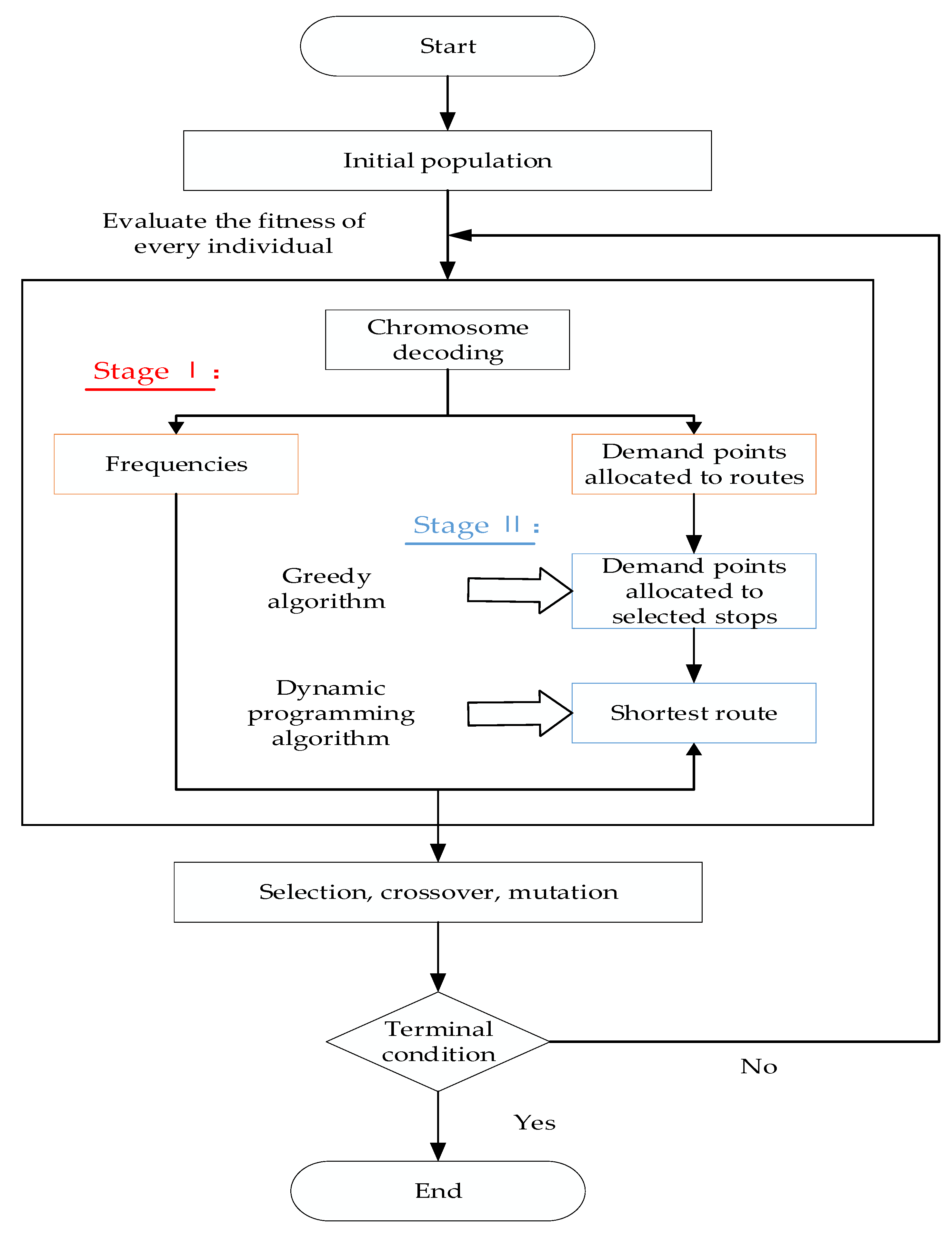
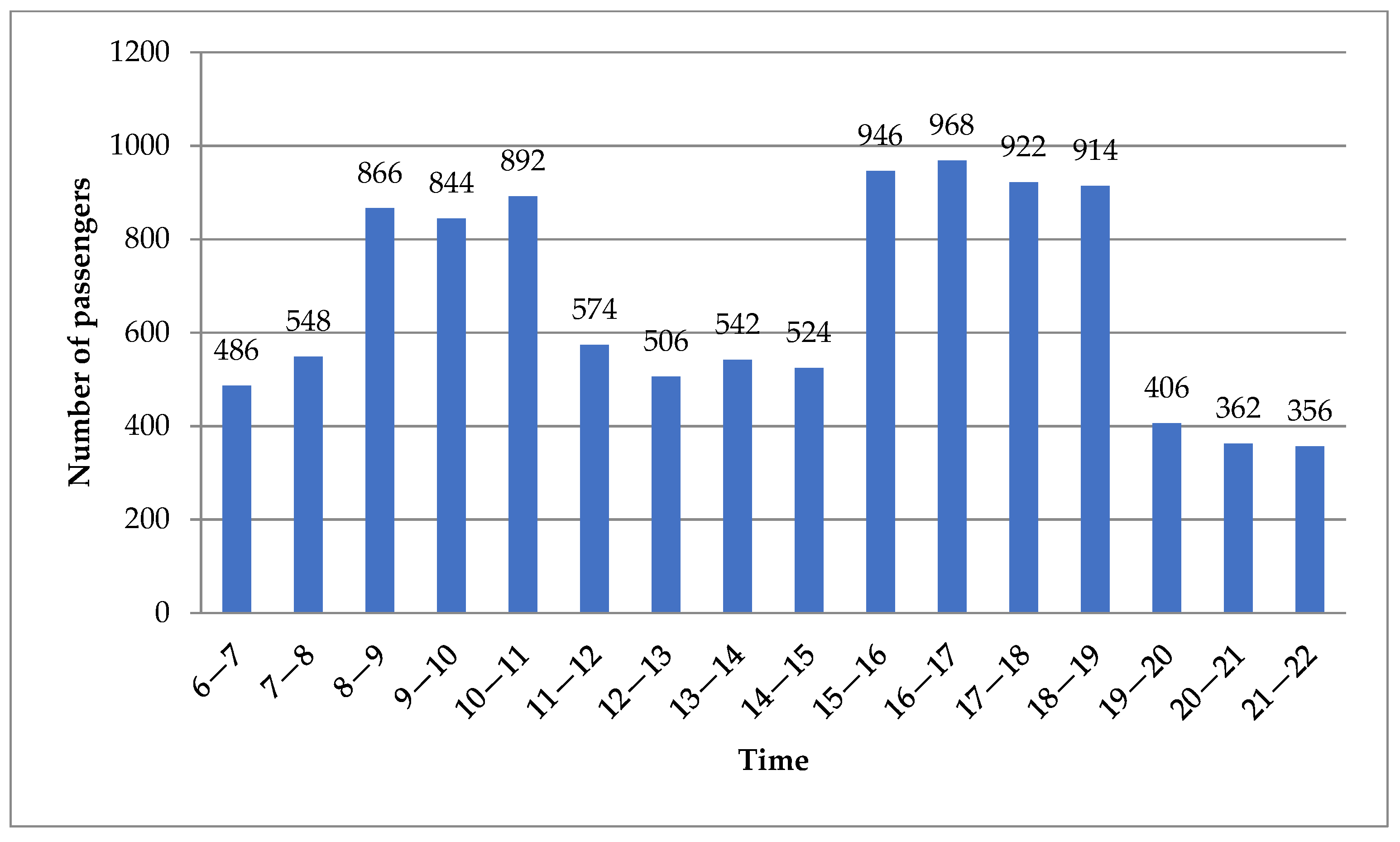
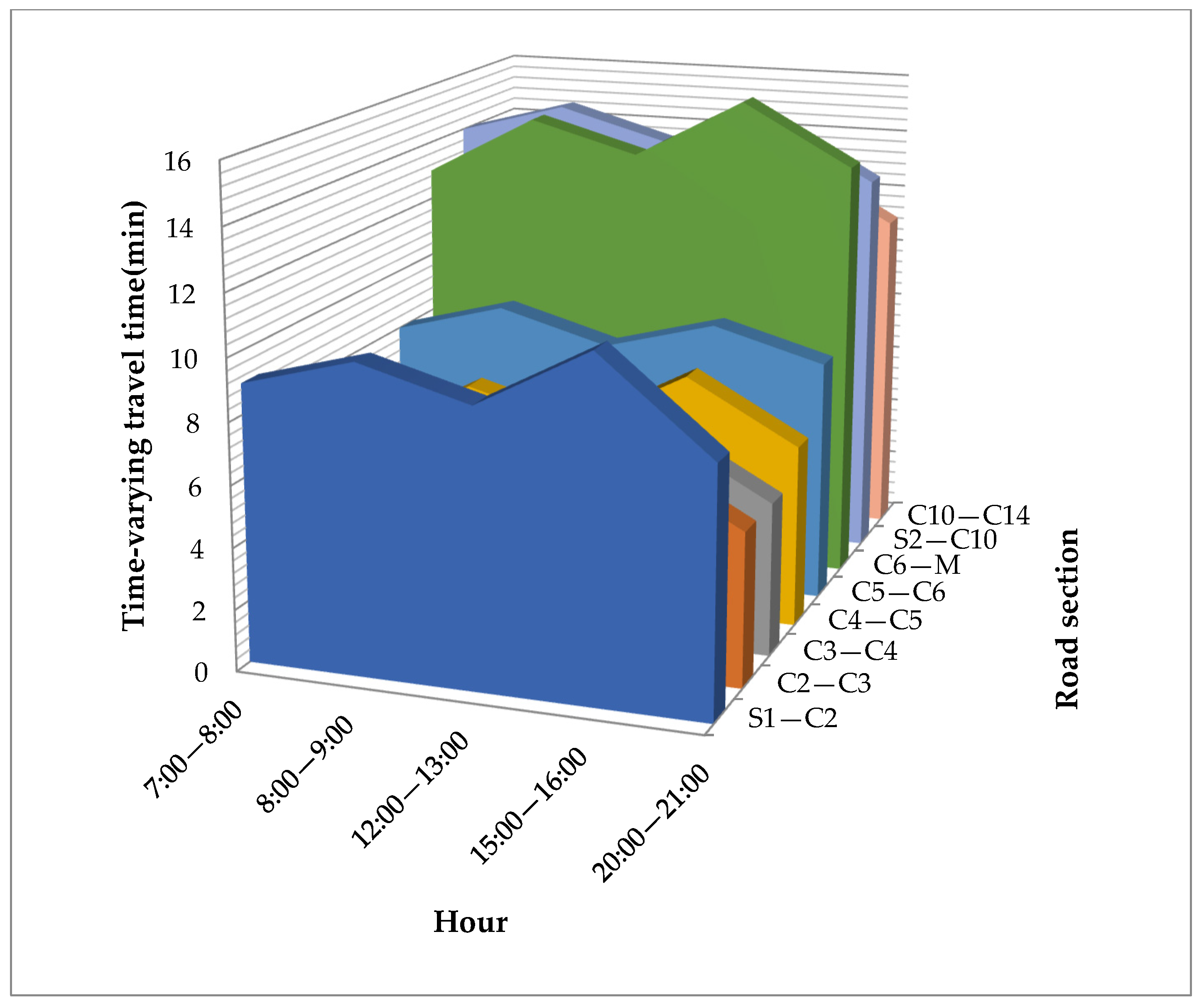
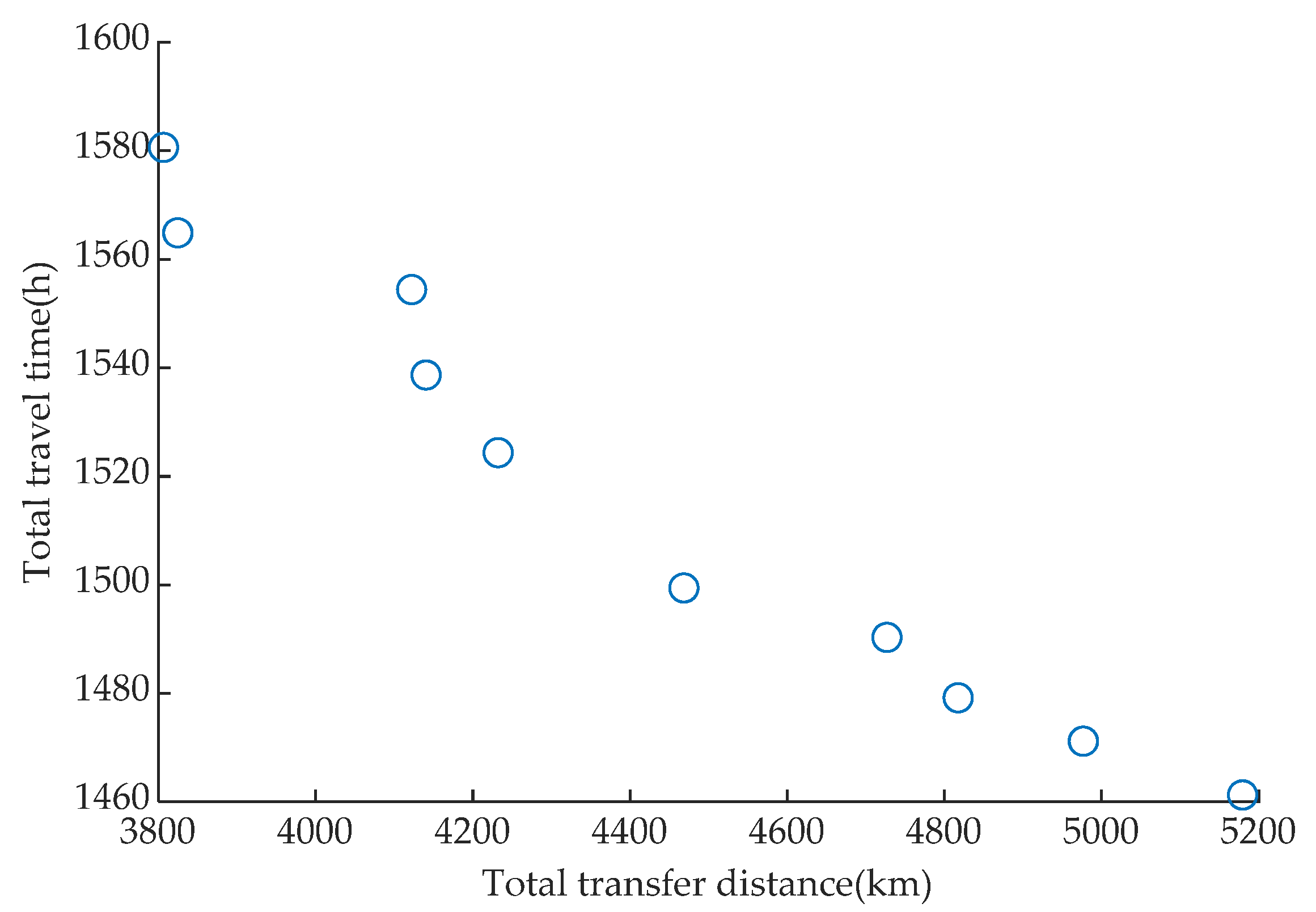
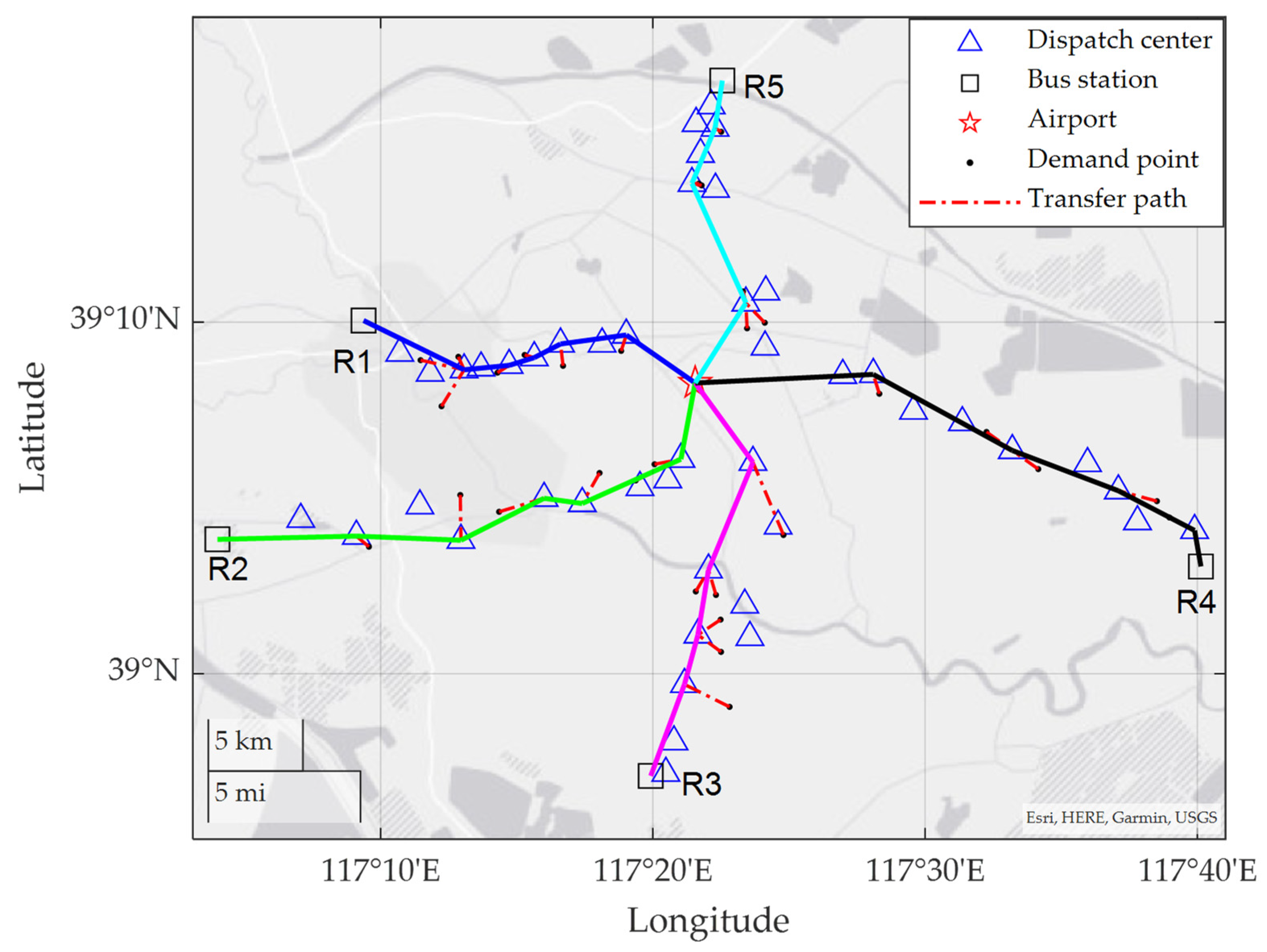
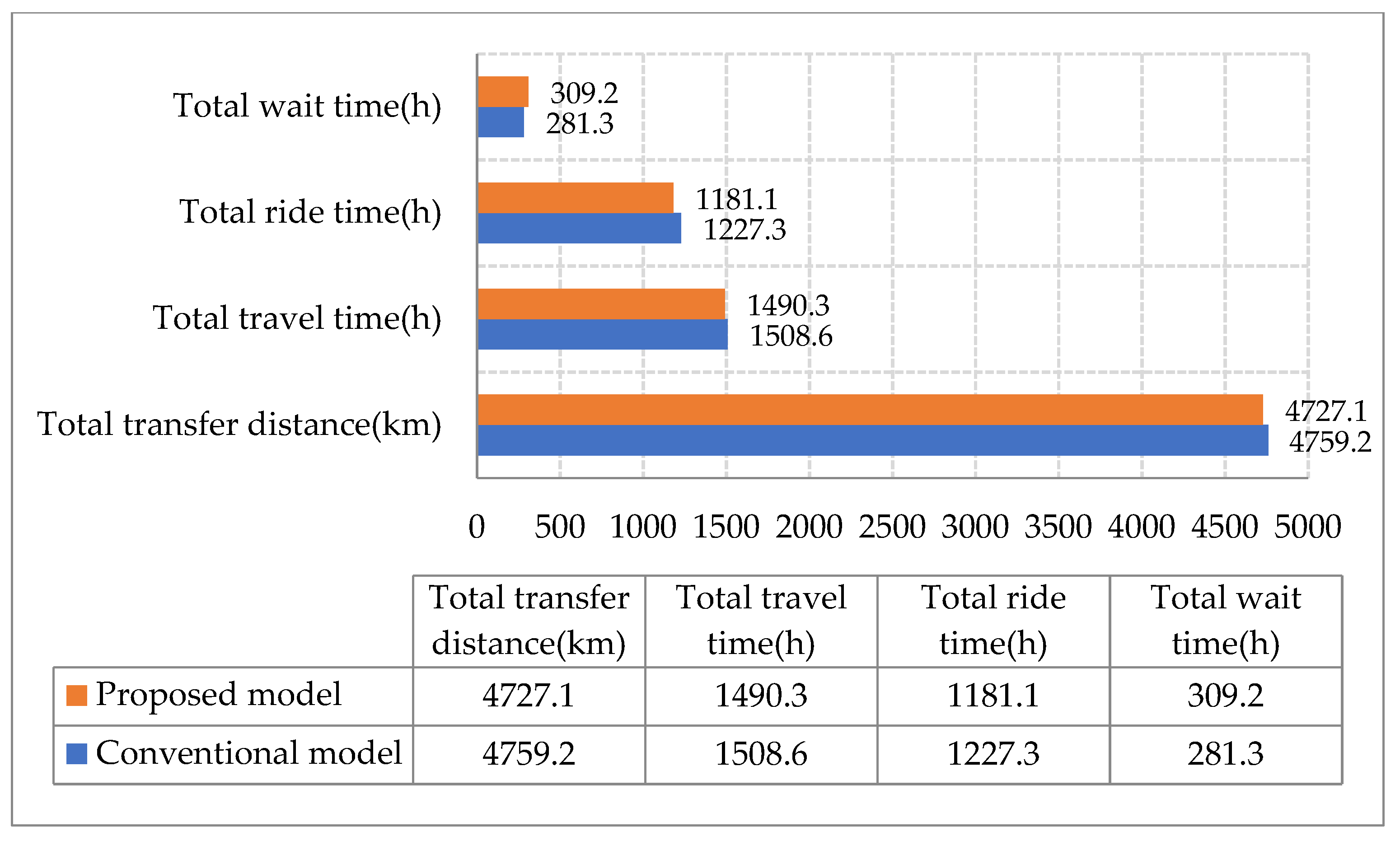
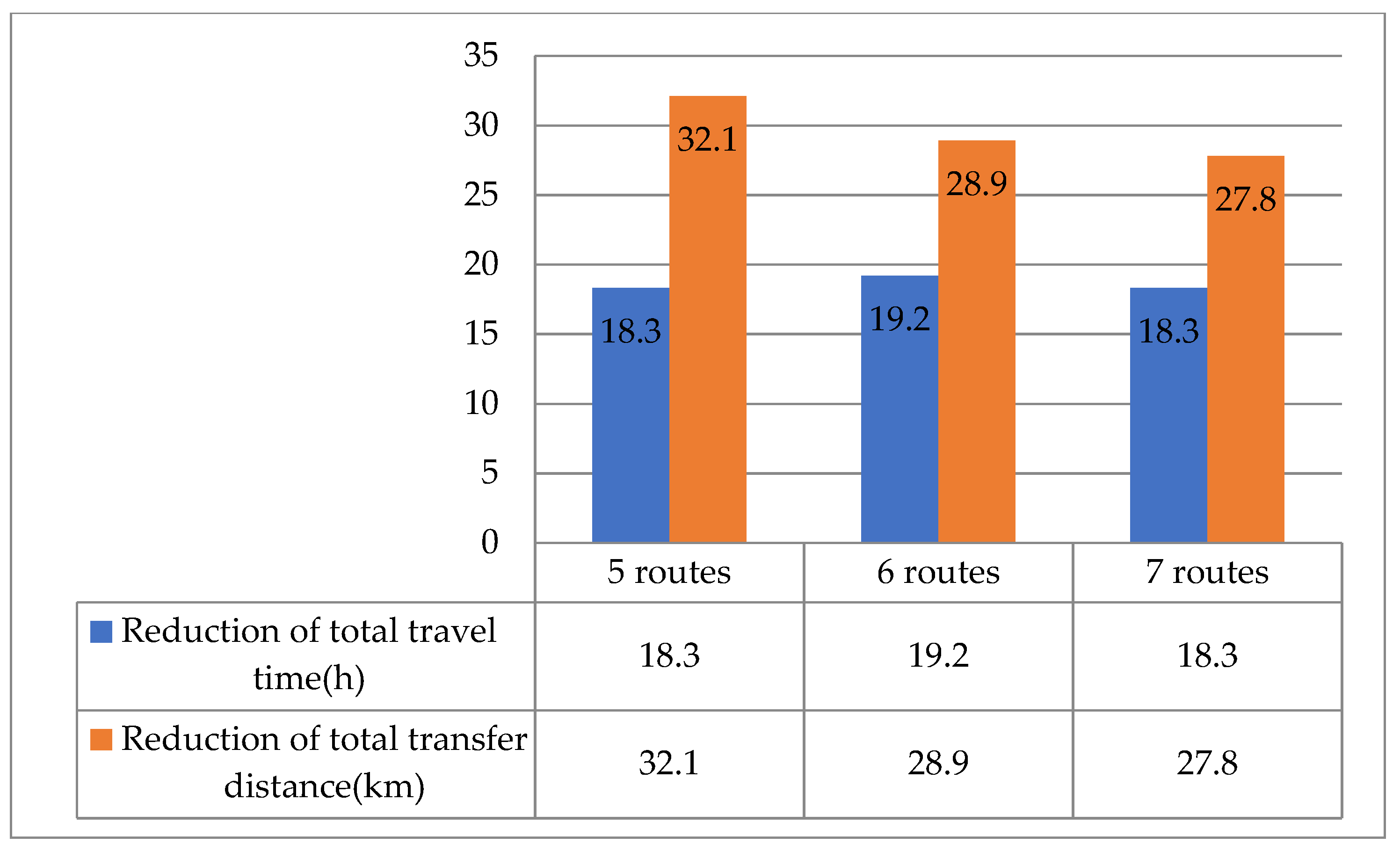

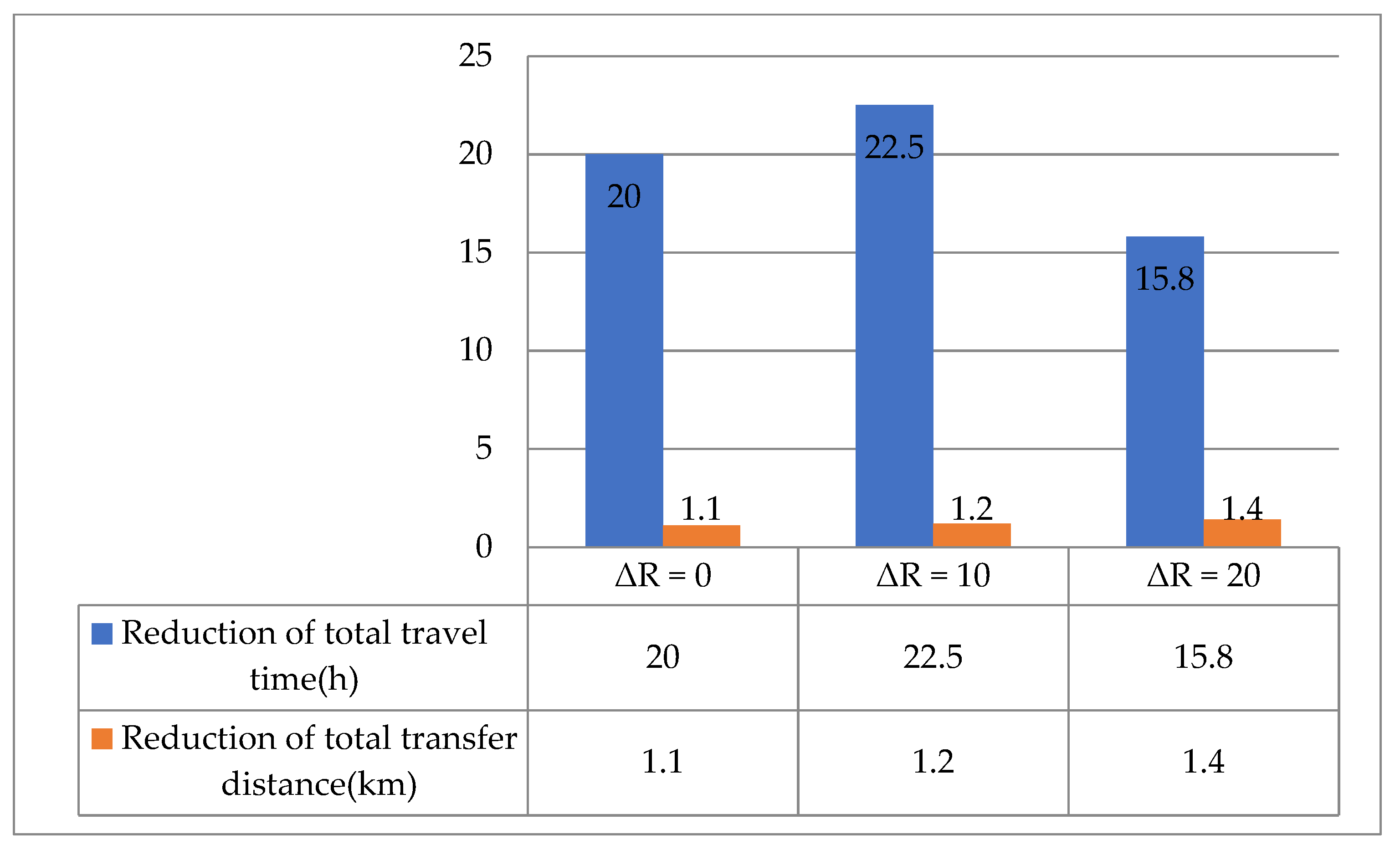
| Demand Pattern | Objective | Solution Method | RD | FD | SS | TVD | Reference |
|---|---|---|---|---|---|---|---|
| Static | The number of passenger transfers | Hybrid artificial bee colony algorithm. | Yes | Yes | No | No | [8] |
| Static | The sum of all passengers’ walking and traveling time. | A two-phase genetic algorithm combining the Dijkstra search method. | Yes | Yes | Yes | No | [12] |
| Static | The total time spent by users; the operational cost | The multi-objective bi-level approach based on global-best harmony search. | Yes | Yes | No | No | [13] |
| Static | The passenger cost; the unmet demand | Differential evolution approach. | Yes | Yes | No | No | [15] |
| Static | The total waiting time of all passengers. | Simulated annealing. | Yes | Yes | No | No | [17] |
| Static | Passenger ride time and operator costs | Corridor generation algorithm. | Yes | Yes | No | No | [18] |
| Static | The time difference between buses that cannot be reached synchronously | A heuristic algorithm | Yes | Yes | No | No | [19] |
| Static | The total operation cost; the total passenger travel cost. | Iterative layered optimization algorithm with forward-passing and backpropagation based on Lagrangian duality | Yes | Yes | Yes | No | [20] |
| Static | Operating costs; total travel times. | An outer approximation method | Yes | Yes | Yes | No | [21] |
| Dynamic | The weighted overall passenger’s waiting time; passengers’ ride time; operation costs. | Improved Lagrangian relaxation algorithm. | Yes | Yes | Yes | No | [22] |
| Dynamic | The amount of time passengers wait for shuttles; the shuttle energy consumption. | A discrete-event simulator | Yes | Yes | No | Yes | [23] |
| Dynamic | Total transfer distance of all passengers; total ride and waiting time of all passengers. | Two-phase NSGA-II-based approach. | Yes | Yes | Yes | Yes | This paper |
| Indices: | |
|---|---|
| Demand point index | |
| Shuttle bus node (dispatch center, station, and airport) index | |
| b | Shuttle bus route index |
| Period index | |
| Sets: | |
| V | Set of demand points |
| B | Set of shuttle bus routes |
| C | Set of alternative stations |
| D | Set of dispatch centers |
| M | Set of airports |
| S | Set of periods |
| Parameters: | |
| Ridership at demand point i in period s; | |
| Q | Maximum capacity of the shuttle bus |
| Maximum departure frequency in period s; | |
| Minimum departure frequency in period s; | |
| Load rate of route b in period s; | |
| Maximum load rate in period s; | |
| Minimum load rate in period s; | |
| Maximum mileage of shuttle bus route | |
| Minimum travel time of shuttle bus route | |
| The total mileage of route b visiting all shuttle bus stations; | |
| The total travel time of route b visiting all shuttle bus stations in period s; | |
| Maximum transfer distance | |
| Map-based distance from the airport, bus stations, and dispatch centers to demand points and , | |
| Map-based time from bus stations and dispatch centers to airport and in period s; | |
| The capacity of bus station j in period s; | |
| A large constant | |
| Decision variables: | |
| Whether the alternative station is selected as a shuttle bus station; | |
| Whether the demand point is allocated to a shuttle bus station ; | |
| Whether the shuttle bus station precedes shuttle bus station e on route ; | |
| Frequency of route b in period s; | |
| Whether the shuttle bus station is served by route b; | |
| The time of route b arriving at the shuttle bus station in period s; | |
| Ridership at the shuttle bus node allocated to route b in period s; | |
| An auxiliary (real) variable for sub-tour elimination constraint in route of shuttle bus b; |
| No. | |||||
|---|---|---|---|---|---|
| D1 | 23 | 36 | 21 | 40 | 15 |
| D2 | 22 | 35 | 20 | 38 | 15 |
| D3 | 18 | 29 | 17 | 31 | 12 |
| D4 | 27 | 43 | 25 | 47 | 18 |
| D5 | 22 | 35 | 20 | 38 | 15 |
| D6 | 16 | 25 | 15 | 28 | 11 |
| D7 | 24 | 38 | 22 | 42 | 16 |
| D8 | 13 | 21 | 12 | 23 | 9 |
| D9 | 19 | 30 | 18 | 33 | 13 |
| D10 | 13 | 21 | 12 | 23 | 9 |
| D11 | 20 | 32 | 19 | 35 | 13 |
| D12 | 15 | 24 | 14 | 26 | 10 |
| D13 | 16 | 25 | 15 | 28 | 11 |
| D14 | 20 | 32 | 19 | 35 | 13 |
| D15 | 15 | 24 | 14 | 26 | 10 |
| D16 | 19 | 30 | 18 | 33 | 13 |
| D17 | 12 | 19 | 11 | 21 | 8 |
| D18 | 13 | 21 | 12 | 23 | 9 |
| D19 | 11 | 17 | 10 | 19 | 7 |
| D20 | 15 | 24 | 14 | 26 | 10 |
| D21 | 24 | 38 | 22 | 42 | 16 |
| D22 | 11 | 17 | 10 | 19 | 7 |
| D23 | 18 | 29 | 17 | 31 | 12 |
| D24 | 12 | 19 | 11 | 21 | 8 |
| D25 | 18 | 29 | 17 | 31 | 12 |
| D26 | 23 | 36 | 21 | 40 | 15 |
| D27 | 26 | 41 | 24 | 45 | 17 |
| D28 | 25 | 40 | 23 | 44 | 17 |
| D29 | 12 | 19 | 11 | 21 | 8 |
| D30 | 24 | 38 | 22 | 42 | 16 |
| Demand Point | Selected Stations | Assigned Route | Transfer Distance (km) |
|---|---|---|---|
| D1 | C2 | R1 | 0.8 |
| D23 | 1.8 | ||
| D2 | C3 | 0.7 | |
| D5 | C4 | 0.7 | |
| D3 | C5 | 0.5 | |
| D4 | C6 | 1.2 | |
| D6 | C7 | 1.1 | |
| D8 | C10 | R2 | 0.9 |
| D7 | C12 | 4.4 | |
| D9 | 2.5 | ||
| D10 | C13 | 1.9 | |
| D12 | C15 | 0.4 | |
| D11 | C16 | 1.1 | |
| D13 | C20 | R3 | 2.7 |
| D15 | C22 | 1.4 | |
| D17 | 1.3 | ||
| D16 | C23 | 4.2 | |
| D14 | C24 | 1.5 | |
| D18 | 1.4 | ||
| D22 | C29 | R4 | 1.4 |
| D19 | C30 | 2.1 | |
| D20 | 1.7 | ||
| D21 | C33 | 1.7 | |
| D24 | C36 | 1.1 | |
| D28 | C41 | R5 | 0.6 |
| D30 | 1.3 | ||
| D29 | C42 | 1.3 | |
| D25 | C43 | 0.4 | |
| D26 | C44 | 0.4 | |
| D27 | 0.5 |
| Route | Sequence of Stations Visited by Routes | Route Mileage (km) | Travel Time (h) | ||||||||||
|---|---|---|---|---|---|---|---|---|---|---|---|---|---|
| R1 | S1-C2-C3-C4-C5-C6-M | 4 | 7 | 4 | 6 | 4 | 1.0 | 0.9 | 1.0 | 1.2 | 0.7 | 19.2 | 0.6 |
| R2 | S2-C10-C14-C12-C17-M | 4 | 7 | 5 | 7 | 4 | 0.7 | 0. 7 | 0.6 | 0.7 | 0.5 | 29.5 | 0.9 |
| R3 | S3-C20-C24-C22-M | 4 | 6 | 3 | 7 | 4 | 0.7 | 0.6 | 0.8 | 0.7 | 0.5 | 22.7 | 0.7 |
| R4 | S4-C28-C29-C36-M | 5 | 8 | 4 | 8 | 3 | 0.5 | 0.5 | 0.5 | 0.5 | 0.5 | 29.7 | 0.9 |
| R5 | S5-C40-C39-C42-M | 3 | 7 | 5 | 7 | 4 | 0.9 | 0.8 | 0.7 | 0.9 | 0.6 | 19.3 | 0.6 |
| Scenario | Total Travel Time (h) | Total Riding Time (h) | Total Waiting Time (h) | Total Transfer Distance (km) | Mean Load Factor | Total Frequency | Total Route Mileage (km) | Total Trip Time (h) |
|---|---|---|---|---|---|---|---|---|
| 5 routes | 1490.3 | 1181.1 | 309.2 | 4727.1 | 0.7067 | 130 | 601.8 | 18.5 |
| 6 routes | 1470.2 | 1155.7 | 314.5 | 4732.4 | 0.6851 | 134 | 695.5 | 21.3 |
| 7 routes | 1448.6 | 1129.3 | 319.3 | 4729.8 | 0.6621 | 139 | 780.5 | 23.8 |
| Scenario | Total Travel Time (h) | Total Riding Time (h) | Total Waiting Time (h) | Total Transfer Distance (km) | Mean Load Factor | Total frequency | Total Route Mileage (km) | Total Trip Time (h) |
|---|---|---|---|---|---|---|---|---|
| Δ = 0 | 1490.3 | 1181.1 | 309.2 | 4791.1 | 0.7067 | 130 | 601.8 | 18.5 |
| Δ = 10 | 1484.3 | 1176.5 | 307.8 | 4798.2 | 0.6902 | 132 | 591.4 | 18.3 |
| Δ = 20 | 1478.1 | 1169.2 | 308.9 | 4809.3 | 0.6959 | 131 | 635.2 | 19.4 |
| Scenario | Total Travel Time (h) | Total Riding Time (h) | Total Waiting Time (h) | Total Transfer Distance (km) | Mean Load Factor | Total Frequency | Total Route Mileage (km) | Total Trip Time (h) |
|---|---|---|---|---|---|---|---|---|
| ΔR = 0 | 1490.3 | 1171.1 | 319.2 | 4727.1 | 0.7067 | 130 | 601.8 | 18.5 |
| ΔR = 0.1 | 1513.7 | 1175.1 | 338.6 | 4731.2 | 0.7223 | 127 | 556.8 | 17.2 |
| ΔR = 0.2 | 1523.6 | 1173.2 | 350.4 | 4729.4 | 0.7468 | 123 | 514.6 | 16.3 |
Publisher’s Note: MDPI stays neutral with regard to jurisdictional claims in published maps and institutional affiliations. |
© 2022 by the authors. Licensee MDPI, Basel, Switzerland. This article is an open access article distributed under the terms and conditions of the Creative Commons Attribution (CC BY) license (https://creativecommons.org/licenses/by/4.0/).
Share and Cite
Wei, M.; Yang, C.; Liu, T. An Integrated Multi-Objective Optimization for Dynamic Airport Shuttle Bus Location, Route Design and Departure Frequency Setting Problem. Int. J. Environ. Res. Public Health 2022, 19, 14469. https://doi.org/10.3390/ijerph192114469
Wei M, Yang C, Liu T. An Integrated Multi-Objective Optimization for Dynamic Airport Shuttle Bus Location, Route Design and Departure Frequency Setting Problem. International Journal of Environmental Research and Public Health. 2022; 19(21):14469. https://doi.org/10.3390/ijerph192114469
Chicago/Turabian StyleWei, Ming, Congxin Yang, and Tao Liu. 2022. "An Integrated Multi-Objective Optimization for Dynamic Airport Shuttle Bus Location, Route Design and Departure Frequency Setting Problem" International Journal of Environmental Research and Public Health 19, no. 21: 14469. https://doi.org/10.3390/ijerph192114469
APA StyleWei, M., Yang, C., & Liu, T. (2022). An Integrated Multi-Objective Optimization for Dynamic Airport Shuttle Bus Location, Route Design and Departure Frequency Setting Problem. International Journal of Environmental Research and Public Health, 19(21), 14469. https://doi.org/10.3390/ijerph192114469






